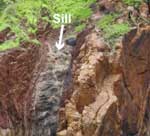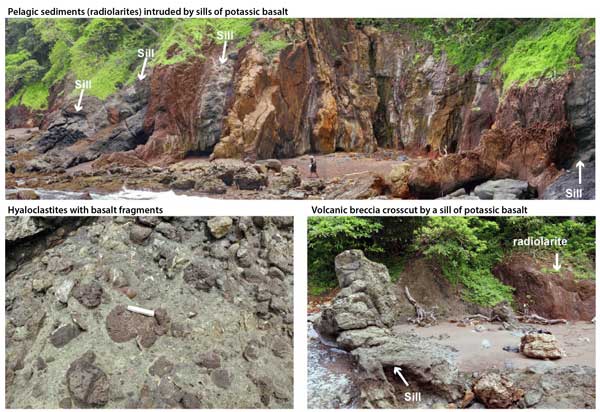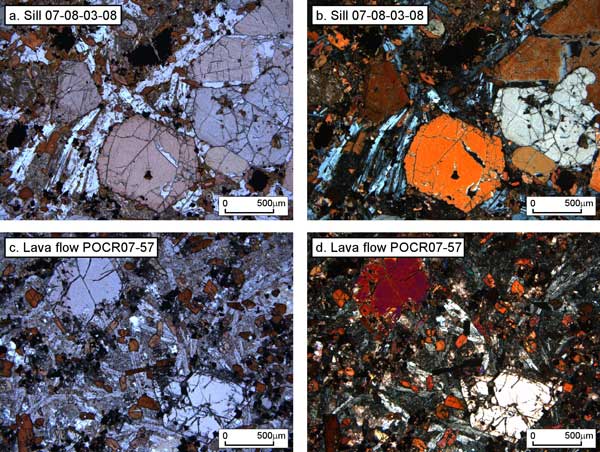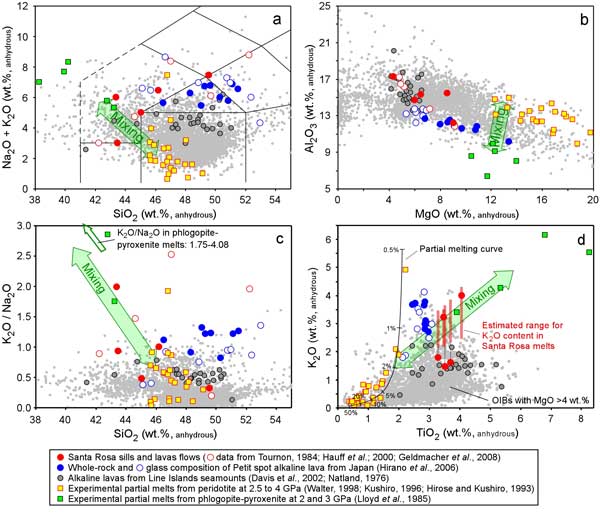 |
Small-sized seamounts composed of potassic alkaline basalt: a record of tectonically-induced volcanism in the ocean? |
David M. Buchs1, Sébastien Pilet2 & Peter O. Baumgartner2
1School of Earth and Ocean Sciences, Cardiff University, UK, BuchsD@cardiff.ac.uk
2Institute of Earth Sciences, University of Lausanne, Switzerland, Sebastien.Pilet@unil.ch ; Peter.Baumgartner@unil.ch
This webpage is a summary of: Buchs, D.M., Pilet, S., Cosca, M., Flores, K.E., Bandini, A.N., Baumgartner, P.O., 2013. Low-volume intraplate volcanism in the Early/Middle Jurassic Pacific basin documented by accreted sequences in Costa Rica. Geochemistry, Geophysics, Geosystems 14, 1552-1568.
Introduction
Our knowledge of the causes and evolution of intraplate volcanism in the oceans is mostly based on the study of relatively large and accessible volcanoes. Nevertheless, 90% of the total seamount population is composed of small-sized (<100 m tall) seamounts with unclear origins (Hillier & Watts, 2007; Wessel et al., 2010). Small topographic features on the ocean floor have proven difficult to locate and sample, yet better understanding the origins of small-sized seamounts could significantly advance our understanding of oceanic intraplate volcanism. Accreted sequences of MORB, oceanic islands, and oceanic plateaux are commonly exposed across the globe (e.g., Isozaki et al., 1990; Kerr et al., 2000; Tatsumi et al., 2000; Xenophontos & Osazawa, 2004; Buchs et al., 2011; Schnur & Gilbert, 2012) and contain significant information on the nature and evolution of the oceanic crust (e.g., Mahoney et al., 1998; Hoernle et al., 2002). Our study is the first to document a small, accreted seamount, which offers a new opportunity to understand better the origins of low-volume intraplate volcanism in the ocean.
Observations and interpretation
The seamount comprises Jurassic sequences embedded in a Cretaceous accretionary complex exposed in Costa Rica (Figure 1). It has lithological and petrological characteristics very similar to those of petit-spot volcanoes formed off Japan in response to slab flexure (Hirano et al., 2006, 2008; Valentine & Hirano, 2010). All these small seamounts are composed of potassic alkaline basalts (Figures 2 and 3), which have rarely been reported in the ocean. However, lithostratigraphic and geochemical data suggest that the Costa Rican seamount formed far from subduction zones in the Jurassic Pacific basin, most likely in a mid-plate setting. Basalts similar to those of the accreted seamount in Costa Rica and the petit-spot volcanoes in Japan also occur along the Line Islands volcanic chain, which has been interpreted to result from tectonically-triggered intraplate volcanism in the Late Cretaceous (Natland, 1976; Davis et al., 2002). The basalts of these different localities are all characterised by high K2O, TiO2 and incompatible element contents.

Figure 1: Characteristic lithofacies of the accreted seamount in north Costa Rica. A Jurassic (ca. 175 Ma) age of formation for the seamount is supported by (1) biostratigraphic dating of radiolarites (early–middle Pliensbachian to early Toarcian) and (2) 40Ar-39Ar step-heating dating of magmatic amphiboles found in the potassic alkaline sills and associated lava flows (173.9 - 177 Ma). A Cretaceous (ca. 110 Ma) age of accretion was determined based on biostratigraphic data from intercalated, near-trench turbiditic sequences. Integration of the lithostratigraphic, age and geochemical constrains suggest that the seamount formed in a mid-plate setting distant from subduction-zone and mid-ocean settings.

Figure 2: Photomicrographs of samples from a Costa Rica sill (07-08-03-08) and lava flow (POCR-07-57). (a, c) Plane polarized light. (b, d) With crossed polars. Note in a-d the porphyric texture of basalts and the different degrees of alteration in the matrix. These rocks are characterized by large phenocrysts of augite (500–2000 µm in size) associated with amphibole and Fe-Ti oxides micro-phenocrysts (500–50 µm in size), which are embedded in a finer grained matrix of plagioclase, augite, amphibole, Fe-Ti oxides, apatite, and glass.
These features cannot be accounted for by fractional crystallisation or by low degrees of partial melting of a peridotitic source representative of the convecting normal mid-ocean-ridge-basalt mantle (DMM) (Prytulak & Elliott, 2007; Figure 3). We propose instead that the major and trace element contents of the potassic alkaline basalts are best explained by a two-step process:
-
Peridotite melts are continuously extracted from the low-velocity zone at the base of the oceanic lithosphere (in the garnet stability field) and percolate through the lower lithosphere producing metasomatic phlogopite pyroxenite veins at depth (Lloyd & Bailey, 1975; Harte et al., 1993);
-
Tectonic stress triggers lithosphere cracking and allows melts from the low-velocity zone to interact with the phlogopite-pyroxenite veins, re-melt them, and mix before reaching the surface to produce potassic lavas. The tectonic stress may be related to plate flexure as in the case of petit-spot volcanoes in Japan (Valentine & Hirano, 2010) or to diffuse lithospheric extension as proposed for seamounts observed in the Line Islands chain (Davis et al., 2002).

Figure 3: Major oxide content and ratio for Costa Rica potassic alkaline sills and associated lava flows compared to ocean island basalts (OIBs, GeoRoc database), and experimental melts from peridotite produced at pressures between 2.5 and 4 GPa (Hirose & Kushiro, 1993; Kushiro, 1996; Walter, 1998) and from phlogopite clinopyroxenite at 2 and 3 GPa (Lloyd et al., 1985). Estimated K content (d) from Costa Rican lava was calculated based on fresh magmatic amphiboles. The figure shows the difficulties in creating the composition of K-rich basalt by the melting of a peridotitic source. In particular, the Al2O3 content of potassic alkaline basalts from Costa Rica and Japan is too low to represent melt from peridotite produced at the base of the lithosphere. We propose that these basalts formed through a mixing of (i) peridotite partial melt extracted from the low-velocity zone observed at the base of the oceanic lithosphere and (ii) melt produced from phlogopite-pyroxenite veins located in the lower part of the lithosphere. In this model the veins are cumulates formed in an earlier stage of melt extraction from the low-velocity zone, during which the melt does not necessarily reach the surface but percolates and differentiates across the lithosphere (Harte et al., 1993). Click here or on Figure for enlargement.
Conclusion
We propose that potassic alkaline basalts found in recent and ancient seamounts at Costa Rica, Japan, and the Line Islands volcanic chain reflect tectonically-induced extraction of melts pre-existing at the base of the oceanic lithosphere. This interpretation explains well the formation of the Costa Rican seamount at ca. 175 Ma, which was a time of significant plate re-organisation and potential cracking in the Pacific basin (Bartolini & Larson, 2001). Overall, our observations and interpretation suggest that small-sized seamounts predominantly composed of potassic alkaline basalt are a common, yet poorly recognised feature in modern oceans.
References
-
Bartolini, A., Larson, R.L., 2001. Pacific microplate and the Pangea supercontinent in the Early to Middle Jurassic. Geology 29, 735-738.
-
Buchs, D.M., Arculus, R.J., Baumgartner, P.O., Ulianov, A., 2011. Oceanic intraplate volcanoes exposed: Example from seamounts accreted in Panama. Geology 39, 335-338.
-
Davis, A.S., Gray, L.B., Clague, D.A., Hein, J.R., 2002. The Line Islands revisited: New 40Ar-39Ar geochronologic evidence for episodes of volcanism due to lithospheric extension. Geochemistry Geophysics Geosystems 3, 1018.
-
Harte, B., Hunter, R.H., Kinny, P.D., 1993. Melt Geometry, Movement and Crystallization, in Relation to Mantle Dykes, Veins and Metasomatism. Philosophical Transactions of the Royal Society of London. Series A: Physical and Engineering Sciences 342, 1-21.
-
Hillier, J.K., Watts, A.B., 2007. Global distribution of seamounts from ship-track bathymetry data. Geophysical Research Letters 34, L13304.
-
Hirano, N., Takahashi, E., Yamamoto, J., Abe, N., Ingle, S.P., Kaneoka, I., Hirata, T., Kimura, J.I., Ishii, T., Ogawa, Y., Machida, S., Suyehiro, K., 2006. Volcanism in response to plate flexure. Science 313, 1426-1428.
-
Hirano, N., Koppers, A.A.P., Takahashi, A., Fujiwara, T., Nakanishi, M., 2008. Seamounts, knolls and petit-spot monogenetic volcanoes on the subducting Pacific Plate. Basin Research 20, 543-553.
-
Hirose, K., Kushiro, I., 1993. Partial melting of dry peridotites at high pressures: Determination of compositions of melts segregated from peridotite using aggregates of diamond. Earth and Planetary Science Letters 114, 477-489.
-
Hoernle, K., van den Bogaard, P., Werner, R., Lissinna, B., Hauff, F., Alvarado, G., Garbe-Schonberg, D., 2002. Missing history (16-71 Ma) of the Galpapagos hotspot: Implications for the tectonic and biological evolution of the Americas. Geology 30, 795-798.
-
Isozaki, Y., Maruyama, S., Furuoka, F., 1990. Accreted Oceanic Materials in Japan. Tectonophysics 181, 179-205.
-
Kerr, A.C., White, R.V., Saunders, A.D., 2000. LIP Reading: Recognizing Oceanic Plateaux in the Geological Record. Journal of Petrology 41, 1041-1056.
-
Kushiro, I., 1996. Partial melting of a fertile mantle peridotite at high pressures: an experimental study using aggregates of diamond, in: Basu, A., Hart, S. (Eds.), Earth Processes: Reading the Isotopic Code, Washington, DC, pp. 109-122.
-
Lloyd, F.E., Bailey, D.K., 1975. Light element metasomatism of the continental mantle: the evidence and the consequences. Physics and Chemistry of the Earth 9, 389–416.
-
Lloyd, F.E., Arima, M., Edgar, A.D., 1985. Partial melting of a phlogopite-clinopyroxenite nodule from south-west Uganda: an experimental study bearing on the origin of highly potassic continental rift volcanics. Contributions to Mineralogy and Petrology 91, 321-329.
-
Mahoney, J.J., Frei, R., Tejada, M.L.G., Mo, X.X., Leat, P.T., Nägler, T.F., 1998. Tracing the Indian Ocean Mantle Domain Through Time: Isotopic Results from Old West Indian, East Tethyan, and South Pacific Seafloor. Journal of Petrology 39, 1285-1306.
-
Natland, J.H., 1976. Petrology of volcanic rocks dredged from seamounts in the Line Islands, Initial Reports of the Deep Sea Drilling Project. Texas A & M University, Ocean Drilling Program, College Station, TX, United States, pp. 749-777.
-
Niu, Y., O'Hara, M.J., 2003. Origin of ocean island basalts: A new perspective from petrology, geochemistry, and mineral physics considerations. Journal of Geophysical Research 108, 2209.
-
Prytulak, J., Elliott T., 2007. TiO2 enrichment in ocean island basalts, Earth and Planetary Science Letters 263, 388–403.
-
Schnur, S.R., Gilbert, L.A., 2012. Detailed volcanostratigraphy of an accreted seamount: Implications for intraplate seamount formation. Geochemistry, Geophysics, Geosystems 13, Q0AM05.
-
Tatsumi, Y., Kani, T., Ishizuka, H., Maruyama, S., Nishimura, Y., 2000. Activation of Pacific mantle plumes during the Carboniferous: Evidence from accretionary complexes in southwest Japan. Geology 28, 580-582.
-
Valentine, G.A., Hirano, N., 2010. Mechanisms of low-flux intraplate volcanic fields--Basin and Range (North America) and northwest Pacific Ocean. Geology 38, 55-58.
-
Walter, M.J., 1998. Melting of Garnet Peridotite and the Origin of Komatiite and Depleted Lithosphere. Journal of Petrology 39, 29-60.
-
Wessel, P., Sandwell, D.T., Kim, S.-S., 2010. The Global Seamount Census. Oceanography 23, 24-33.
-
Xenophontos, C., Osozawa, S., 2004. Travel time of accreted igneous assemblages in western Pacific orogenic belts and their associated sedimentary rocks. Tectonophysics 393, 241-261.
last updated 19th
December, 2013 |
